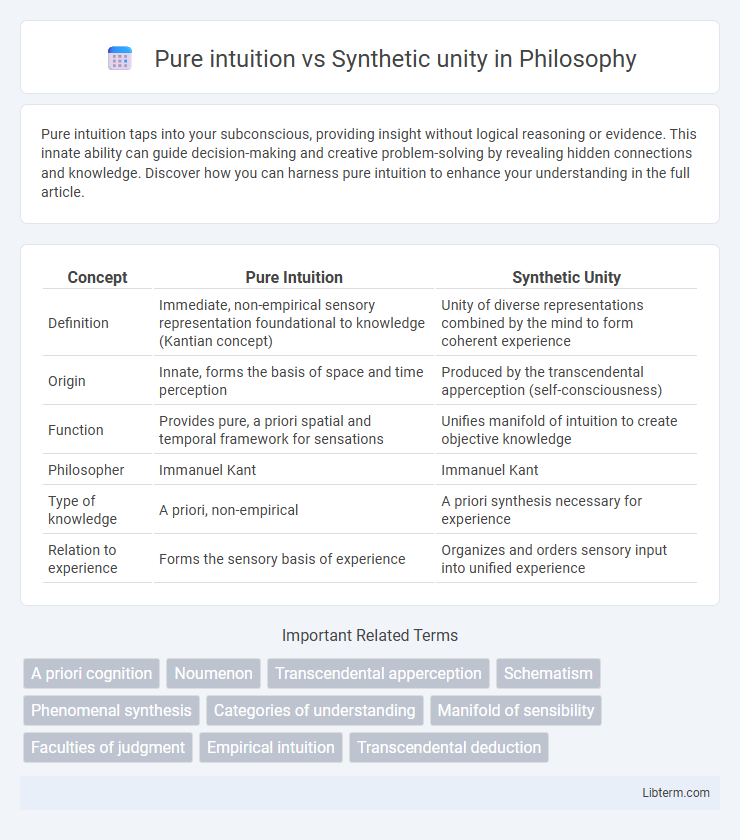Pure intuition taps into your subconscious, providing insight without logical reasoning or evidence. This innate ability can guide decision-making and creative problem-solving by revealing hidden connections and knowledge. Discover how you can harness pure intuition to enhance your understanding in the full article.
Table of Comparison
| Concept | Pure Intuition | Synthetic Unity |
|---|---|---|
| Definition | Immediate, non-empirical sensory representation foundational to knowledge (Kantian concept) | Unity of diverse representations combined by the mind to form coherent experience |
| Origin | Innate, forms the basis of space and time perception | Produced by the transcendental apperception (self-consciousness) |
| Function | Provides pure, a priori spatial and temporal framework for sensations | Unifies manifold of intuition to create objective knowledge |
| Philosopher | Immanuel Kant | Immanuel Kant |
| Type of knowledge | A priori, non-empirical | A priori synthesis necessary for experience |
| Relation to experience | Forms the sensory basis of experience | Organizes and orders sensory input into unified experience |
Defining Pure Intuition: Origins and Meaning
Pure intuition, a key concept in Kantian philosophy, refers to the immediate, non-discursive way in which sensory data is given to the mind prior to conceptualization. It originates from Immanuel Kant's critique of knowledge, distinguishing between a priori knowledge structures and empirical input, where pure intuitions are the forms of sensibility--space and time--that shape all experiences independently of empirical content. This foundational notion defines pure intuition as the pre-conceptual framework enabling synthetic unity by organizing sensations into coherent representations.
The Concept of Synthetic Unity in Philosophy
The concept of synthetic unity in philosophy refers to the mind's ability to combine diverse sensory inputs into a coherent and unified experience. This unity is essential for the formation of knowledge, as it allows the synthesis of different representations under a single consciousness. Immanuel Kant emphasized synthetic unity as the foundation for the possibility of experience, distinguishing it from mere intuition by integrating multiple elements into a holistic cognitive framework.
Historical Context: Kant's Influence on Both Terms
Immanuel Kant's philosophy established pure intuition as the a priori, non-empirical forms of sensibility shaping human experience, specifically space and time. His concept of synthetic unity of apperception describes the mind's ability to unify diverse sensory inputs into coherent self-consciousness. Kant's critical framework transformed epistemology by linking pure intuitions with the synthetic unity that underpins knowledge acquisition.
Pure Intuition in Mathematics and Perception
Pure intuition in mathematics refers to the immediate, non-empirical insight into spatial and temporal structures, enabling the understanding of fundamental concepts such as points, lines, and succession without sensory experience. Unlike synthetic unity, which synthesizes diverse experiences into cohesive knowledge, pure intuition provides the foundational framework for perceiving and representing mathematical objects directly. This intrinsic capacity highlights the role of a priori spatial-temporal forms in shaping human perception and abstract reasoning beyond empirical data.
Synthetic Unity and the Structure of Consciousness
Synthetic unity of apperception is the fundamental process that unifies diverse sensory inputs into a coherent experience, enabling the structure of consciousness to maintain self-awareness over time. This unity synthesizes manifold representations through the transcendental faculty, forming a single, integrated consciousness that underpins objective knowledge. The structure of consciousness relies on this synthetic unity to organize temporal sequences and conceptual categories, ensuring that perception and cognition are experienced as a unified whole.
Comparative Analysis: Key Differences
Pure intuition refers to the immediate, non-conceptual sensory experience that provides the foundational data for knowledge, while synthetic unity involves the active combination of these sensory inputs through the mind's conceptual framework to produce coherent understanding. Pure intuition is characterized by its a priori nature, offering raw, unanalyzed content such as space and time, whereas synthetic unity is a product of the transcendental unity of apperception that synthesizes this manifold into a unified consciousness. The key difference lies in pure intuition supplying the content of experience, and synthetic unity structuring that content into meaningful knowledge through cognitive synthesis.
Real-World Applications of Pure Intuition
Pure intuition, as defined in Kantian philosophy, refers to the a priori sensibility of space and time essential for structuring human experience without reliance on empirical data. Real-world applications of pure intuition are evident in fields like computer graphics and virtual reality, where spatial and temporal frameworks enable the creation of immersive environments independent of sensory input. This synthetic unity allows for the seamless integration of diverse data streams, enhancing technologies in navigation systems and robotic perception.
The Role of Synthetic Unity in Cognitive Processes
Synthetic unity plays a crucial role in cognitive processes by enabling the mind to combine various sensory inputs into a coherent and unified experience. This cognitive synthesis allows the formation of concepts and judgments that go beyond mere empirical observation, fostering higher-order thinking and knowledge construction. By integrating disparate data streams, synthetic unity underpins the organized structure of consciousness necessary for intentional thought and understanding.
Debates and Critiques: Philosophical Perspectives
Debates surrounding pure intuition and synthetic unity highlight tensions between Kantian epistemology and empiricist critiques questioning the a priori nature of synthetic judgments. Philosophers argue whether synthetic unity genuinely synthesizes concepts independently of experience or if it is contingent on empirical data, challenging Kant's assertion of universal and necessary knowledge. Contemporary critiques explore the limits of pure intuition in accommodating diverse cognitive frameworks and the role of synthetic unity in evolving theories of mind and knowledge.
Integrating Pure Intuition and Synthetic Unity
Integrating pure intuition and synthetic unity involves combining the immediate, non-conceptual apprehension of space and time with the mind's active capacity to unify diverse representations into coherent experience. Pure intuition provides the foundational sensory forms through which phenomena are directly given, while synthetic unity organizes these intuitions under a single, self-conscious framework enabling objective knowledge. This integration is crucial in Kantian epistemology, ensuring that raw sensory data becomes structured, meaningful cognition.
Pure intuition Infographic

 libterm.com
libterm.com